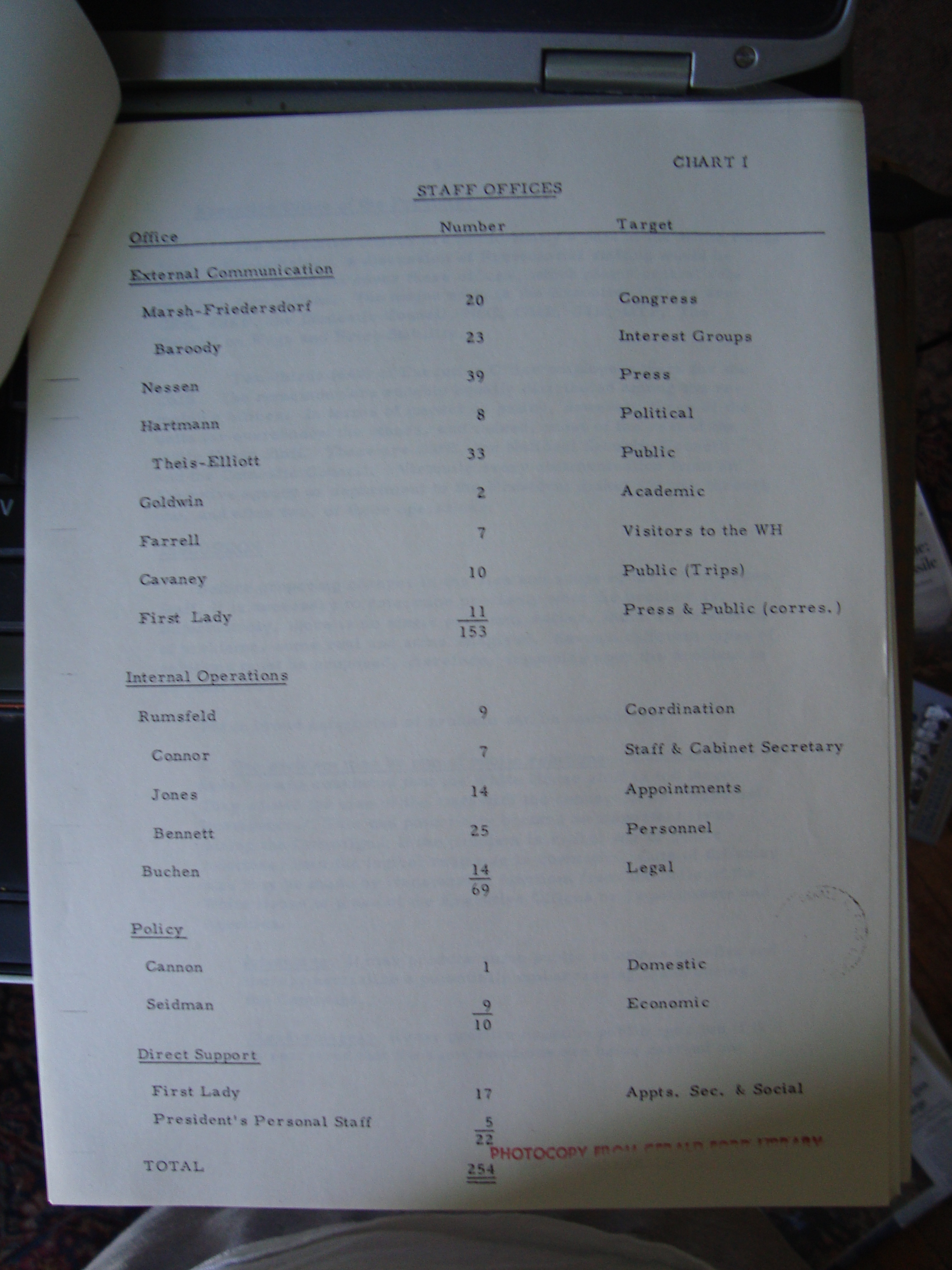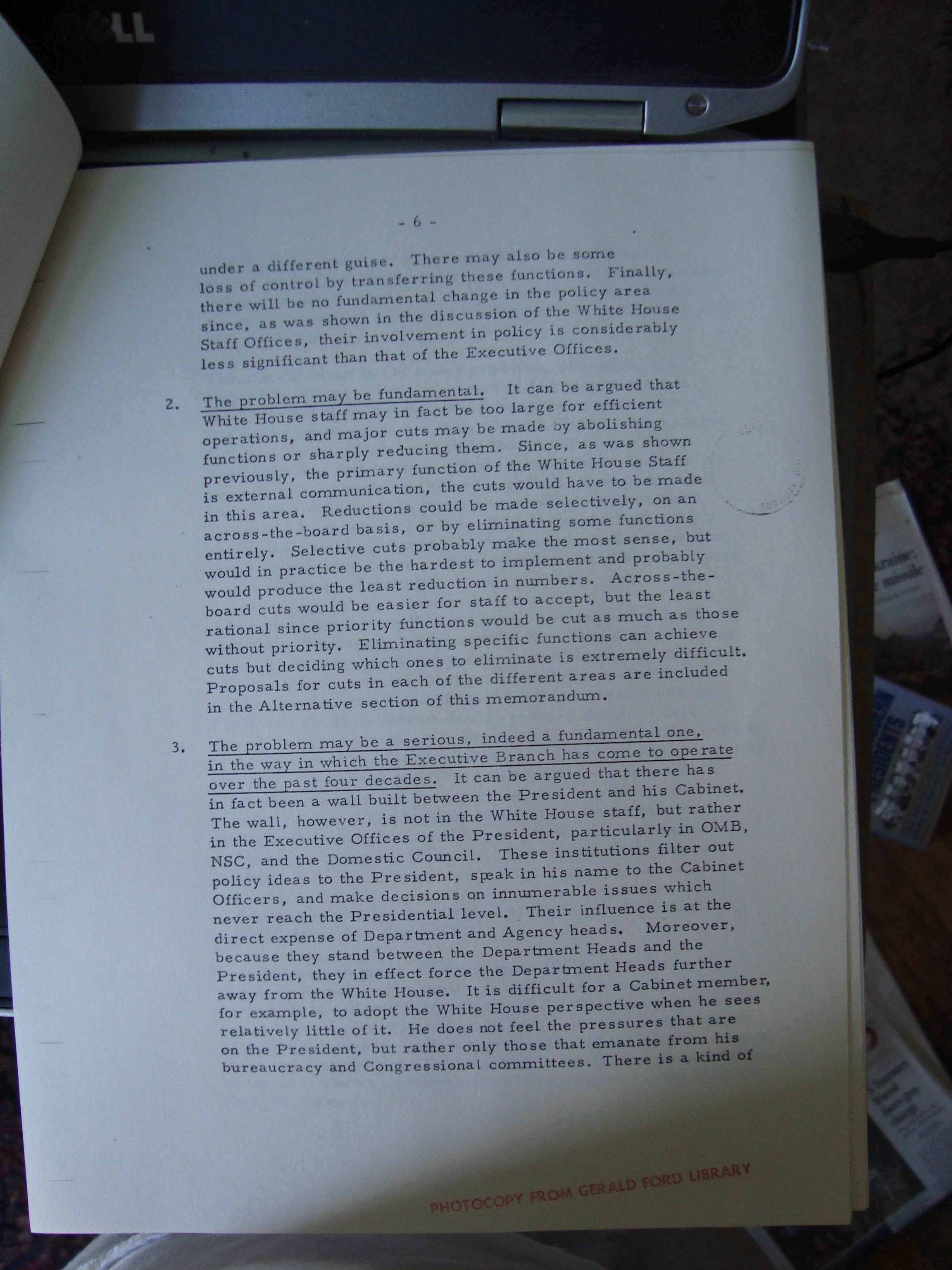Regular readers know that every Saturday we look back, via archives I’ve collected through the years, at a key (or at least interesting!) event in presidential history. Today’s original documents come from the Ford Administration, and remind us that Don Rumsfeld and Dick Cheney both served as senior members of the Ford White House before going on to greater glory, and both were involved in one of the first, and most thorough efforts to reduce the size and power of the White House staff.
Ford, most of you will recall, became President in August 1974 upon President Richard Nixon’s resignation in the wake of the ongoing revelations in the Watergate scandal that threatened Nixon with almost certain impeachment. Much of that scandal centered on the actions of Nixon’s senior White House staff – the so-called Palace Guard – which was accused of operating as an increasingly powerful and largely unaccountable political arm of the Presidency. As Ford’s White House assistant James Connor wrote in an August 29, 1975 memo to Donald Rumsfeld, Ford’s Chief of Staff, “Until recently, the expansion of the role of the White House has been viewed as a salutary, and indeed a necessary step in the development of governmental institutions dealing with the complexity of modern problems.” The Watergate scandal, however, had reversed that perception, so that now “the size, scope and role of the White House staff became an issue of public debate.”
Ford was determined to show that the actions of his White House staff would be more transparent and more accountable than were the actions of Nixon’s “Berlin Wall” of H.R. Haldeman, John Ehrlichman and Henry Kissinger. Toward this end, Ford initially decided to govern without a strong chief of staff to manage the White House on his behalf. (That experiment did not last long, and ultimately Ford appointed Rumsfeld to be his chief of staff, with Cheney as Rumsfeld’s deputy assistant.) And, because he was determined to demonstrate his fiscal bona fides, Ford – who was an expert on the budget due to his years as member of Congress – initiated a White House study project under Rumsfeld’s direction designed to make sense of what the White House staff did, and whether some positions might be eliminated in the name of cost-cutting.
That study was more successful at documenting the history and related functions of the White House staff than it was in reducing its size. (Ford’s successor, Jimmy Carter, would undertake a similar effort, and with a similar lack of long-term success.) The final report was issued in December 1976 (by this time Cheney had become chief of staff), a month after Ford lost a very close election to Carter, and so was never acted on. But the study does a very good job explaining what the White House staff did, and in many respects the analysis holds true today.
Among the more interesting documents were those showing a breakdown of White House staff positions and functions. Broadly speaking, about half of Ford’s White House staff, or about 250 individuals, were quasi-civil servants charged with providing administrative and clerical duties, such as handling correspondence, filing, making the payroll, etc. The second and more interesting half was the political staff – the “West Wing” of the day. Here’s a document from the internal study showing the proportion of aides engaged in external relations, internal staff management, and policy development.
As you can see, by far the largest proportion – 60% (or about 153) – are engaged in dealing with external relations with Congress, interest groups, the press and the public. In contrast, only 25% (69) of staff under Rumsfeld deal with internal management. But perhaps the most interesting finding is just how small the policy component is, with only 10 staff aides focused on managing the policy process. This reflects the fact that most policy still emanated from the departments and agencies, and that the major policy units within the Executive Office of the President (EOP) were all located outside the White House proper. At the time these included the OMB, which contained 2/3 of EOP employees, the National Security Council and the Domestic Council – the latter first created by Nixon. In addition, Ford had established an Economic Policy Board via executive order to serve as counterpart to the Domestic Council. All three councils exist today.
The report serves as a reminder that the White House staff is largely a political institution – not a policy one. Its primary purpose is to maintain the president’s standing with the key constituents with whom he (someday she) must deal on a constant basis. That remains the case today – most of the White House staff positions in the Obama presidency are focused on handling political relations.
But the report also noted a potentially more fundamental and disturbing trend. In his memo to Ford, Connor writes, “It can be argued that there has in fact been a wall built between the President and his Cabinet. The wall, however, in not in the White House staff, but rather in the Executive Office of the President, particularly in the OMB, NSC and Domestic Council. These institutions filter out policy ideas to the President, speak in his name to the Cabinet Officers, and make decisions on innumerable issues which never reach the Presidential Level. Their influence is at the direct expense of Department and Agency heads… . As the Cabinet Officer is moved further and further away he is less and less sensitive to the president’s needs….the end result of this process is that the President looks out upon the bureaucracy as an enemy.” Here’s the original portion of the report – see subheading three below:
To remedy the situation, Connor advocates for more direct interaction between the President and his cabinet and agency heads. “Were this approach to be adopted, it would be the most far-reaching change in the Presidency in the last forty years.” Alas, Ford never had the opportunity to act on Connor’s suggestions, and there is no evidence that subsequent presidents have been any more successful at integrating their departmental and agencies more effectively into the policymaking process. There are several reasons for this which I hope to address in future posts.
Today, however, the West Wing under President Obama remains quite similar in terms of size and functions from what it was under Ford. And that is a testament to its fundamental character as the personal arm of the President, devoted solely to his political success.


